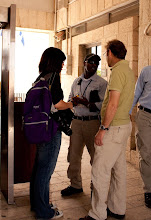on the bus, i befriended a jewish woman, who made עליה to israel 5 months ago from canada. she lives in a jewish settlement 10 mins away from hebron. she told me that the bus initially traveled on hebron road before the building of the rail commenced and when it was 'safer.' after the bus was attacked on many accounts, a tunnel highway was built that bypassed the initial entry into the west bank. after 10 mins on the bus, the travelers on the left side were treated to an amazing view of the wall cutting through the landscape. i am still astounded by how close jerusalem is to the west bank area, being nearly encompassed by the giant concrete structure on almost all sides. the ride was mostly uneventful but i appreciated seeing the landscape of israel for the most part. there is a certain beauty in the hilly, deserted terrain, dotted with housing complexes or the occasional rundown buildings occupied mostly by arabs. there were also several farms along the way and i think with a little stretch of my imagination, this is probably what the area looked like 2000 years ago.... that actually might be too far a stretch.
hebron. what to say about hebron. a little history: hebron is the largest city in the west bank. it is the biblical region of judea and it is the second holiest city of judaism, after jerusalem. the most famous site of hebron is the cave of patriarchs. even though the site is holy to judaism, both christianity and islam hold the site sacred due to the connection with abraham. he bought a piece of land to bury his wife, sarah, and afterwards abraham, issac, leah, jacob, rebecca are all buried there. in recent history, as any piece of arabic land, there has been many tense conflicts between arabs and israelis. hebron is heavily patrolled by israeli military guards. rabbi moshe levinger and his wife began colonising the centre of town after israel incorporated the west bank in 1967. even though this move was illegal, it gained endorsement, even after the settlement of kiryat arba was established to draw the settlers out. each armed settler in the old city is protected by as many as four armed soldiers, who are stationed on rooftops and street corners, emboldening the ~600 jews there to parade in the streets chanting anti-arab calls and wielding guns. on february of 1994, baruch goldstein, a physician, entered the ibrahimi mosque and open fired on the praying palestinians. palestinians believe the israeli jews are stealing their rightful land and protest against the military occupation. the israeli jews believe they have every right to occupy hebron because it was jewish under abraham. however, it appears as if the palestinians always get the wrong end of the bargain. their homes are constantly decimated or taken over. they face constant harassment from the settlers.
the egged bus dropped me off in the old city. so my initial viewing of hebron was very unsettling. i was surrounded by crumbling structures, closed shops, graves, pro-zionist graffiti and gun-toting civilians and soldiers. i thought that this was hebron itself. i was mistaken after some research. even though the area looks unpopulated, there are people, both arab and jew, walking around the streets. there are many palestinian and israeli flags flying from windows and houses. however, there are more of the latter. everyone seems to be very welcoming and friendly. i visited the muslim part of the cave of patriarchs. a man there gave me a brief tour, beginning with donning of a head covering. the mosque is one of the more unassuming ones i've visited but the humbleness is appealing. there is a shrine of a stone with an imprint of a foot. my guide told me that this is abraham's footprint. interesting. i also visited the tomb of abraham, isaac and rebecca. in all, my stay was brief as service was going to start soon.
i am glad that i picked this as my project. i will get to explore a place where most people are unwilling to go to because of the heavy military occupation and threat of danger. this is one of the few times i am thankful i'm from abroad.






